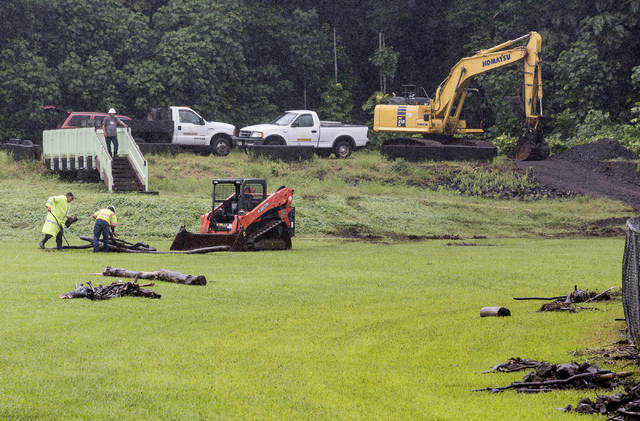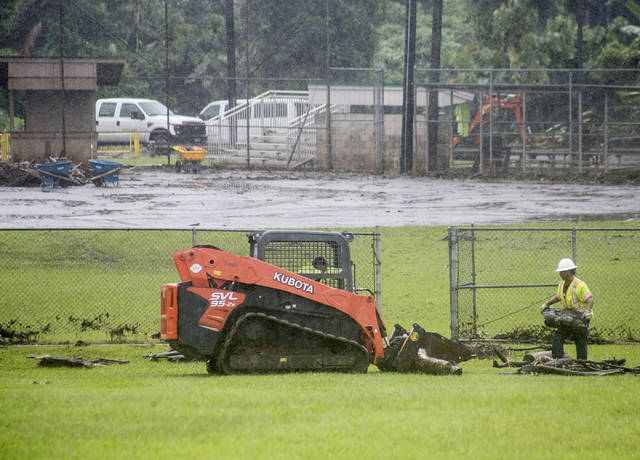HILO — Federal Emergency Management Director Brock Long is on the Big Island in the wake of Hurricane Lane. Meanwhile, Hawaii Emergency Management Director Tom Travis said he hopes preliminary figures from the ongoing damage assessment statewide can be tabulated by Monday.
Long spoke during the morning briefing of county officials and emergency responders Wednesday at Civil Defense headquarters in Hilo.
“Our role at FEMA is to clearly understand how to support the governor’s response and recovery initiatives to ultimately help you, mayor,” Long said, turning to Mayor Harry Kim.
Long said the federal agency charged with disaster response and recovery “learned a great deal” from 2017, a year in which parts of the U.S. and its territories were devastated by hurricanes Harvey, Irma and Maria.
“One of the things that we’ve learned from 2017, and that we’re trying to push forward, is that emergency response and management works best when it’s locally executed, state managed and federally supported, and not the other way around,” Long told those assembled. “… My advice to you is to leave no stone unturned. Let’s go quickly as we can and not rush the process, to make sure that you’re entitled to everything that can come down from the federal government in the future.”
According to Kim, Travis told the mayor Monday — which is Labor Day — is the target date by which some preliminary numbers should be available to send to the federal government.
“Monday is fast. We’ll hopefully cross our fingers and get the federal declaration of individual assistance, but at the very minimum, public assistance,” Kim said. The mayor noted assessments had to be done for Maui and Kauai, as well, for inclusion in Travis’ preliminary report to the feds.
“The current schedule is to get (monetary assessments) done so we can speak coherently about it by Monday,” Travis said after the briefing.
Kim said that some of the Big Island’s “most devastated areas are in Puna.”
“Orchidland, Fern Acres, Hawaiian Acres, that area,” he said. “… When the water comes raging down, where there are roads, are riverbeds. … That’s where some homes are lost, in Orchidland.”
Kim said growth in substandard subdivisions happened so fast “that we built in harm’s way.”
The official tally of Big Island damage as of Wednesday, which is not complete, was two homes destroyed, which were earlier reported in Hawaiian Acres, 18 suffering major damage and 86 affected. Businesses affected were 16, two suffering major damage and none destroyed.
Those numbers do not include damage to public infrastructure and will almost certainly increase, perhaps dramatically.
Kim said Big Islanders are “extremely lucky” state and federal emergency management personnel who were on island because of Kilauea’s lower East Rift Zone eruption remained during Hurricane Lane.
“That’s not normal. It does not happen in 49 other states and territories, that we have this kind of personal assistance here, in this room, here with us 24 hours a day, before the emergency occurs,” he said.
Long said afterward he’s here because “the state of Hawaii’s been through a lot.”
“Not just with the most recent events from Hurricane Lane, but obviously the Big Island has seen a lot of devastation from … the ongoing volcano,” he said. “But then the western part of the state also had major flooding back in April. So the combination of all those events makes it very important to make sure that we continue to fine-tune the relationship and our levels of preparedness and our response plans to be able to support the state of Hawaii. And Hurricane Lane serves as a wake-up call. While there was some devastation, and people lost their homes and their lives were put in danger, it could’ve been a lot worse. …
“Last year taught us that we’ve got to do a lot more when it comes to pre-disaster mitigation. I think you’re going to see less loss of life and less loss of property if we start investing in pre-disaster mitigation. And a lot of the funding that is made available for mitigation is made available only after you’ve been hit by a disaster, which is a regressive approach. So, we need true changes in legislation to put more pre-disaster mitigation up front to lessen the impact on the back end.”
Gov. David Ige’s office announced that Long and U.S. Department of Homeland Security Director Kirstjen Nielsen will participate in a joint media conference with Ige at noon today regarding response to Lane, the Kilauea eruption and the April floods.
Hawaii Island residents with damage are urged to report it to authorities by calling 643-5555. That number also can be used to request cleanup assistance.
As the remnants of Lane are now far to the west of Hawaii Island, forecasters have their eyes on two more hurricanes, including one in the Central Pacific. Miriam and Norman were upgraded to Category 1 hurricanes from tropical storm status as of Wednesday.
As of 5 p.m. Wednesday, Miriam was 1,020 miles east-southeast of Hilo, packing maximum sustained winds of 75 mph, moving to the west at 8 mph. A turn toward the west-northwest with a decrease in forward speed is expected tonight, followed by a turn toward the northwest and north through Friday night, which is expected to bring it into cooler waters.
Hurricane force winds extend outward up to 25 miles from the center and tropical storm force winds extend outward up to 105 miles.
The current track has it moving far to the east of the Big Island.
As of 5 p.m. Wednesday, Norman, which is still in the Eastern Pacific, was about 550 miles southwest of the southern tip of Baja California, with maximum sustained winds of 85 mph, moving to the west at 8 mph.
This general track, with a turn to the west-southwest is forecast for the next several days.
Rapid intensification is forecast, and Norman is expected to become a major hurricane today.
Email John Burnett at jburnett@hawaiitribune-herald.com.








